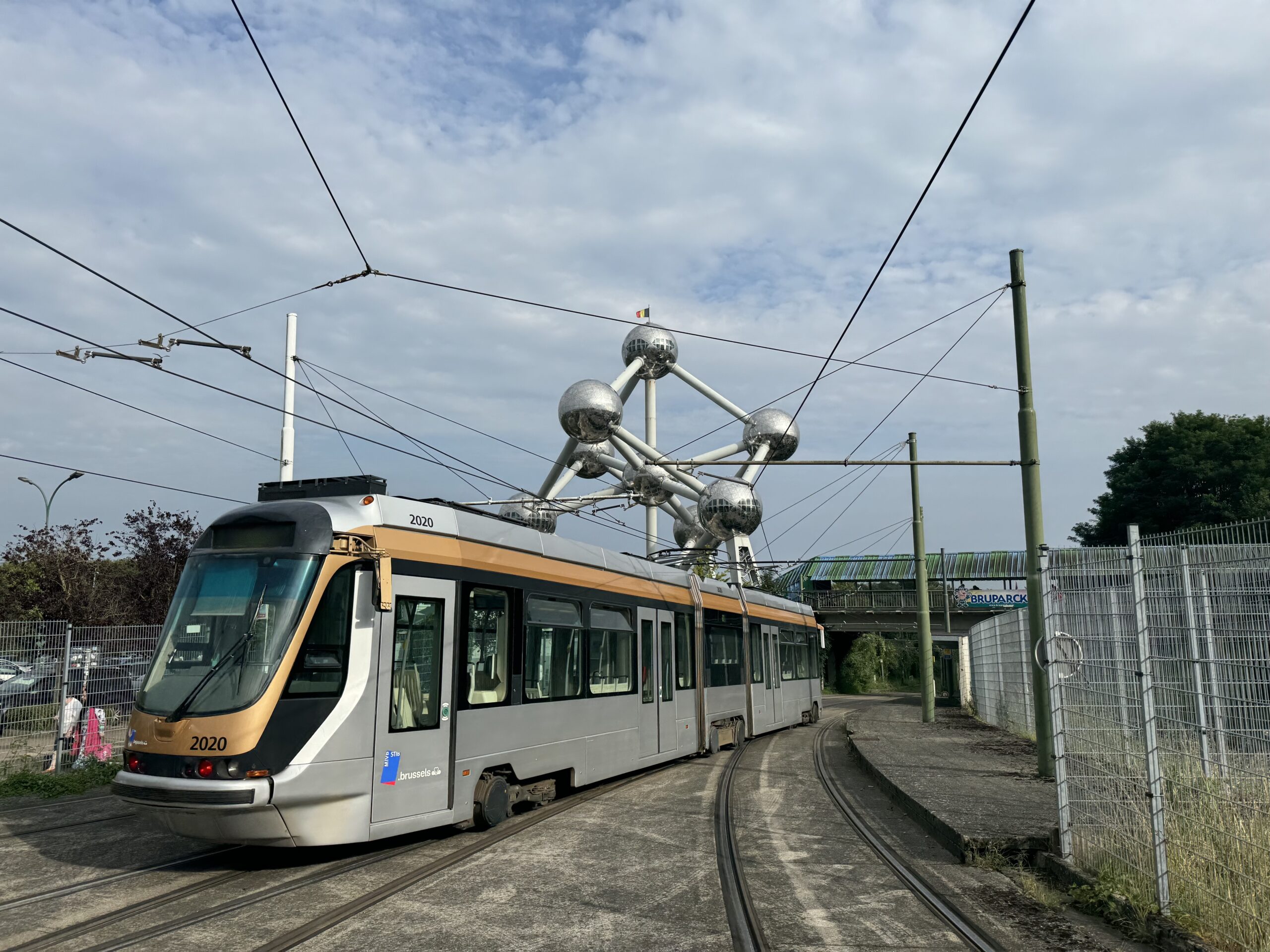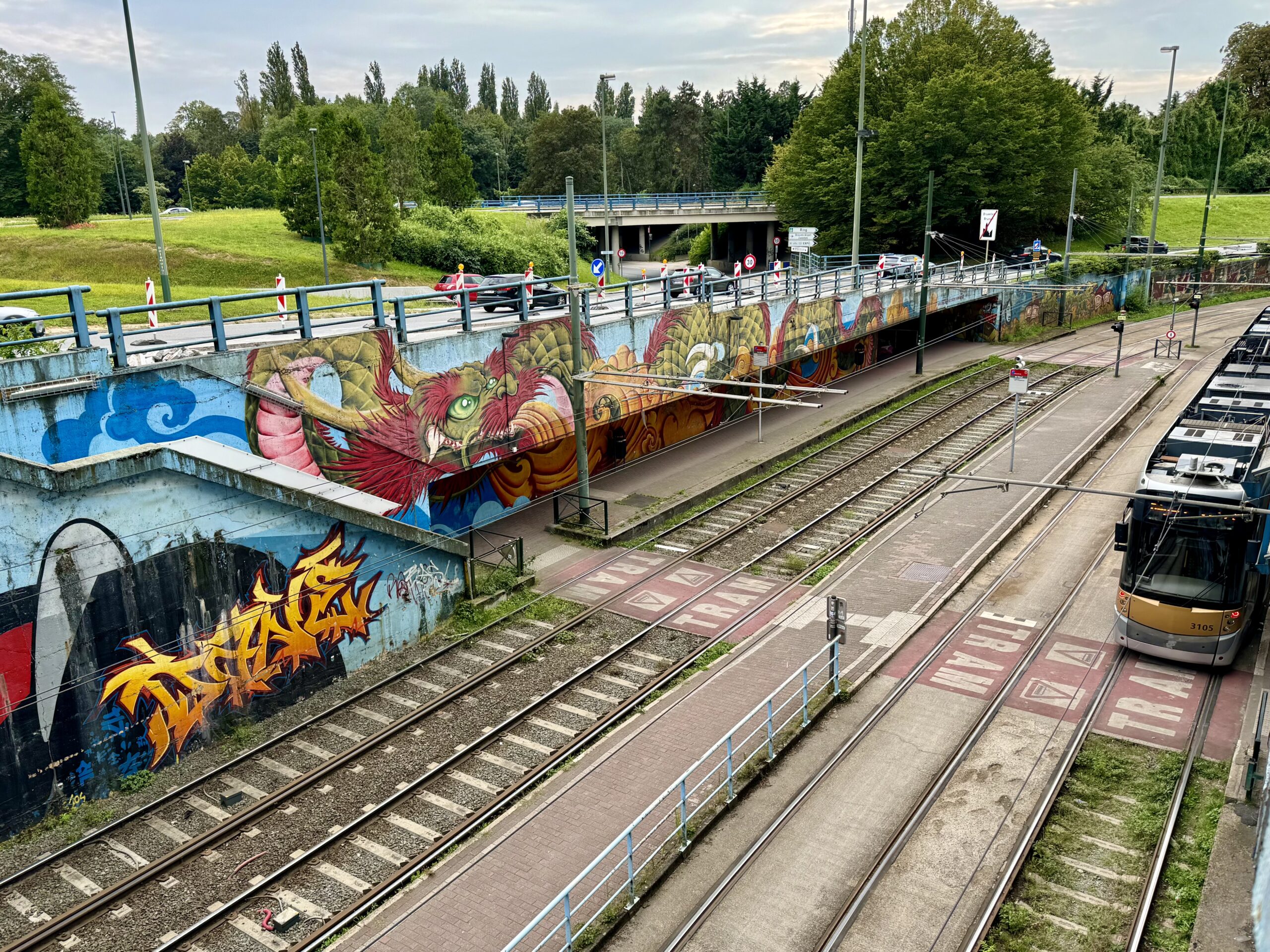Tram 7 crosses Brussels more or less from north to south on the western side. I wrote about it a few years ago for The Brussels Times online but I hope to gain a different perspective if only by riding it in the opposite direction, that is from north to south.
The route begins at Heysel, a vast park area dominated by the Atomium. Now a symbol of Brussels, the monument was built for 1958 World's Fair. When I arrived here 50 odd years ago it was still showing the, by then somewhat tired, scientific exhibits from '58.
This museum closed and there were rumours that the authorities planned to demolish the entire structure. They offered the nine metal balls to the nine original provinces of Belgium (it was built to symbolise them in the first place). It is said the offer was politely declined! The Atomium was spruced up and now – ah, Belgium! – has a lunchtime restaurant at the top with a spectacular view over the city.
Nearby is the King Baudouin stadium. It is the reincarnation of the old Heysel stadium which was rebuilt and renamed after tragedy befell during the 1985 European Cup Final. A fight broke out between the rival Liverpool and Juventus football fans who should have been separated, and they were – but by chicken wire! The resultant crush led to the collapse of a wall, 39 deaths, hundreds of injuries, the banning of British teams from international tournaments, several thugs jailed, and much soul searching among Belgian police and politicians.
I remember the eerie, sombre mood in the city that night as cafés and pubs closed up, cars left the streets, and, quite literally, a state of siege was declared. On a more positive note: a (very crowded) late night 7 took us home after seeing the Rolling Stones there in later, and much happier, times!
It is not often one can get excited about tram stops themselves that tend to be functional and litter strewn. But the second and third stops, on the 7’s southerly arc around western Brussels, are worthy of comment. Firstly Saint Lambert. A small village square on the edge of Heysel Park, it has the gimcrack appeal of so many corners of forgotten Brussels. It is cobbled, with a now disused church, old fashioned lamps, weeds and working-class cottages scattered about. From the ground, under-lit, it would serve well enough as a film-noir set. I say from the ground because, in one aerial photo of it, the narrow church spire and surrounding dense and hilly woodland might, to the fevered imagination, recall a New England village – cover the ubiquitous red brick with white clapboard and you’re there!
Graffiti tunnel
The tram then rattles through a stygian tunnel and emerges blinking at De Wand. The stop is well below street level but uncovered, in a sort of canyon. Commuters must shimmy up a steep staircase, through a well-kept garden, to the heady delights of suburban Laeken. To compensate the authorities have sanctioned a sort of outdoor graffiti art gallery. It is well worth lifting one’s head from phone or book to gaze at the impressive range of funky street characters – who, in their turn, gaze soulfully back.
The tram now hurtles downhill towards the canal. To the right in the direction of travel is a thin strip of woodland, then the incoming old road from Antwerp and beyond that the venerable, barbed-wire topped, red-brick wall of the Royal Palace. It is the official and private residence of the Belgian monarch. It is not to be confused with the Royal Palace in the middle of town which is used for official business. The former, built in 1784 as the summer residence of the governors of the Hapsburg Netherlands, had its gardens designed by none other than English uber-gardener ‘Capability’ Brown (his nickname was not a reference to his skills at making the man-made look natural, but rather his habit of pronouncing that a piece of land had “capability” or potential).
The greenhouses are open to the public in late April and May for the early flowering season. To my shame in 50 years of living in this burg, I have never availed myself of that opportunity – but resolve to do so in 2025! The tram then plunges into another tunnel, emerges and swings sharply to the left over the canal and stops at Docks Bruxsel, a newish mall which opened just before Covid had the entire country online shopping. It appears to have survived.
If you are of a mind, it is worth getting off here, crossing the busy road, and descending to the small approach road to the now-abandoned, town dump. If that sounds unromantic, it is. However, there is a metal bridge where the Senne/Zenne river emerges from its underground course through Brussels. In the 1860s, so foul and noisome had it become it was too much for even strong, industrial age stomachs, it got itself entirely covered over.
Now, as seen from the little bridge, the banks are verdant, the water babbling and clean, and the waterfowl abundant. A bucolic vista hemmed around by an unlovely, canal-side, industrial landscape! Excitingly the city has now firm plans to open up another 650 metres of the river near the old Citroen building. On a more unhappy note, it was into this river, a further 10 kilometres downstream, that the ashes of William Tyndall, translator of the King James Bible, were cast after he was first strangled then burnt at the stake outside Vilvoorde Castle in 1536.
Bubbles in the park
The tram climbs up the hill towards Josaphat Park; sandwiched as it is between the somewhat pretentiously name Quartier des Fleurs, a handsome 1930s suburban development of substantial houses on the one side, and small tenements and the Turkish quarter on the other.
These two separate bubbles come together in the park, at least in the summer. Musical evenings around the bandstand in the mile-square urban greenery attract red-trousered professional types with angora sweaters draped over their shoulders, large Muslim families armed with bottles of water and sandwiches, Black kids dancing up a storm, elderly, foularded, Belgian ladies smiling tolerantly, and teenage goths a-flirting. Sometimes at the nearby ginguette (small hut serving drinks) couples dance to the bar loudspeaker on the cambered grass outside. Not easy but they manage; and look very happy doing so. In the winter inpromptu football games vie with popinjay, that peculiar form of vertical archery. One participant assured me that there had been a popinjay club in “this very spot” since medieval times. I am unable to confirm this.
Just beyond the park is the Clockarium, a small museum dedicated to faïance - tin glazed pottery - clocks, 1,300 of them, at Boulevard Reyers 163. The museum appears to be temporarily closed but its website promises that it will open again in late summer. The collection is private and is dedicated to art moulded clocks with sidepieces either side of the face. Quite the thing in the early part of the last century they were done for by the advent of the wristwatch. All of them are set at ten-to-ten apparently because this makes them look like a smiley and, no small consideration, they don’t have to be wound up every day.
At Place Meiser – dubbed Place Misère for its bottlenecking propensities - the tram plunges underground and stays there through the so-called pre-metro stations of Diamant, Georges-Henri, Montgomery and Boileau until emerging at Pétillon on the handsome Boulevard Louis Schmidt.
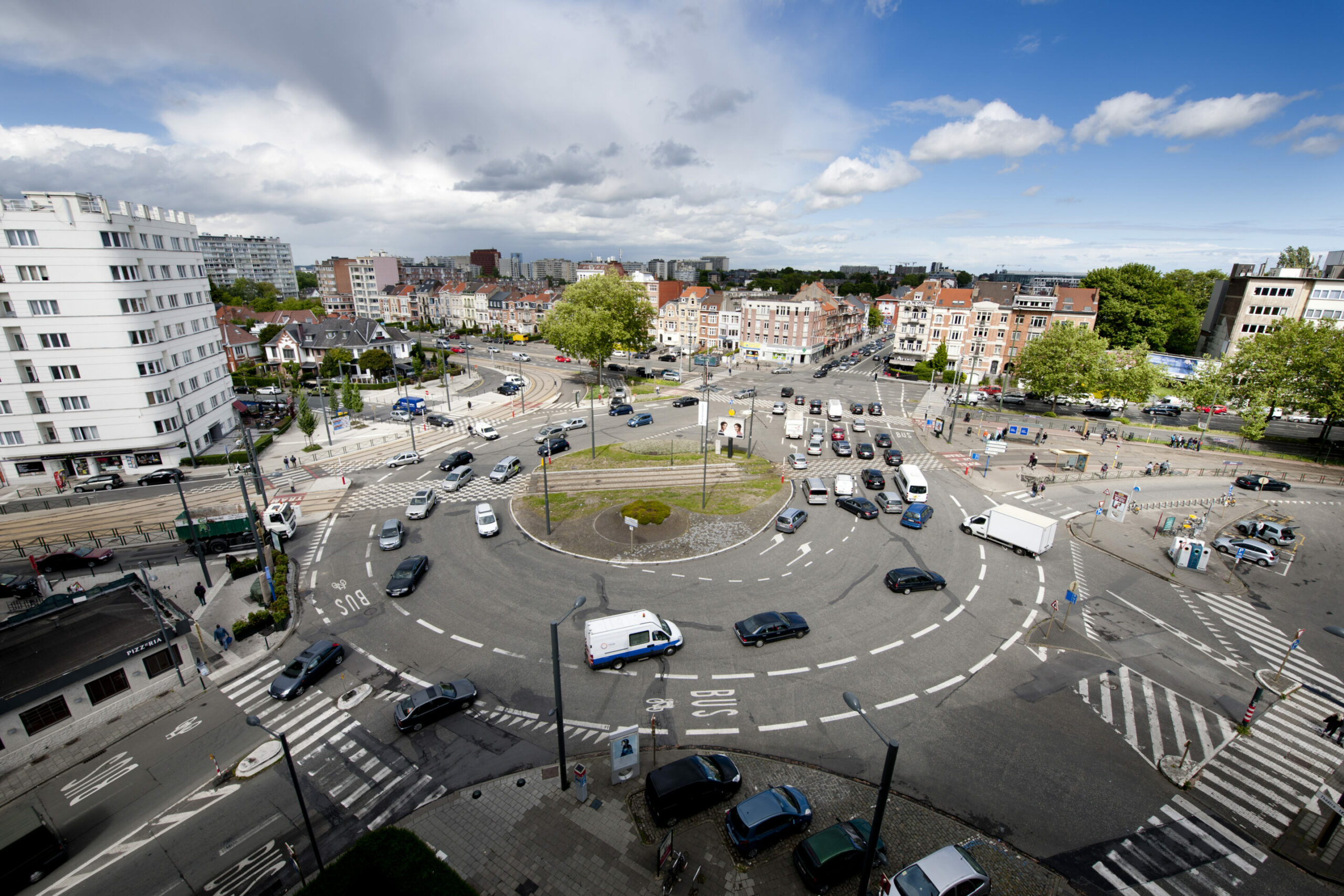
Place Meiser.
It is one of those peculiar stops where you get out at the left, rather than right, side of the tram. The announcement in English exhorts passengers to “alight on the left side in the direction of the traffic”. This prompted puzzled questions from my English pupils who wanted to know if “alight” was anything to do with lightening the weight of the tram. I was able to inform them, after a certain amount of diligent research, that no, its roots are in a 6,000-year-old old word for getting off a horse!
The tram stops at the VUB (Vrije Universiteit Brussel) campus. This stretches eastwards over about a square kilometre and appears to grow organically year by year. It comprises, inter alia, a mishmash of architectural styles, hidden paths, patches of greenery, lecture halls, high schools (well, one), grassy knolls, a swimming pool, a commercial gym, drop-in classes, pretty young people – ill-dressed or dapper – scurrying from class to class, cafés, beer halls, a rugby pub and a swimming pool. I once tried to walk diagonally across it and got hopelessly disoriented. I ended up, after half an hour, frustratingly exiting more or less where I had entered.
I saw an 18th century Austrian map of the city and the campus area still had its current shape but a different usage. It was an army firing range! This makes perfect sense. On the other side of the boulevard, now called General Jacques, are a massive set of former barracks and other army buildings, now being re-purposed.
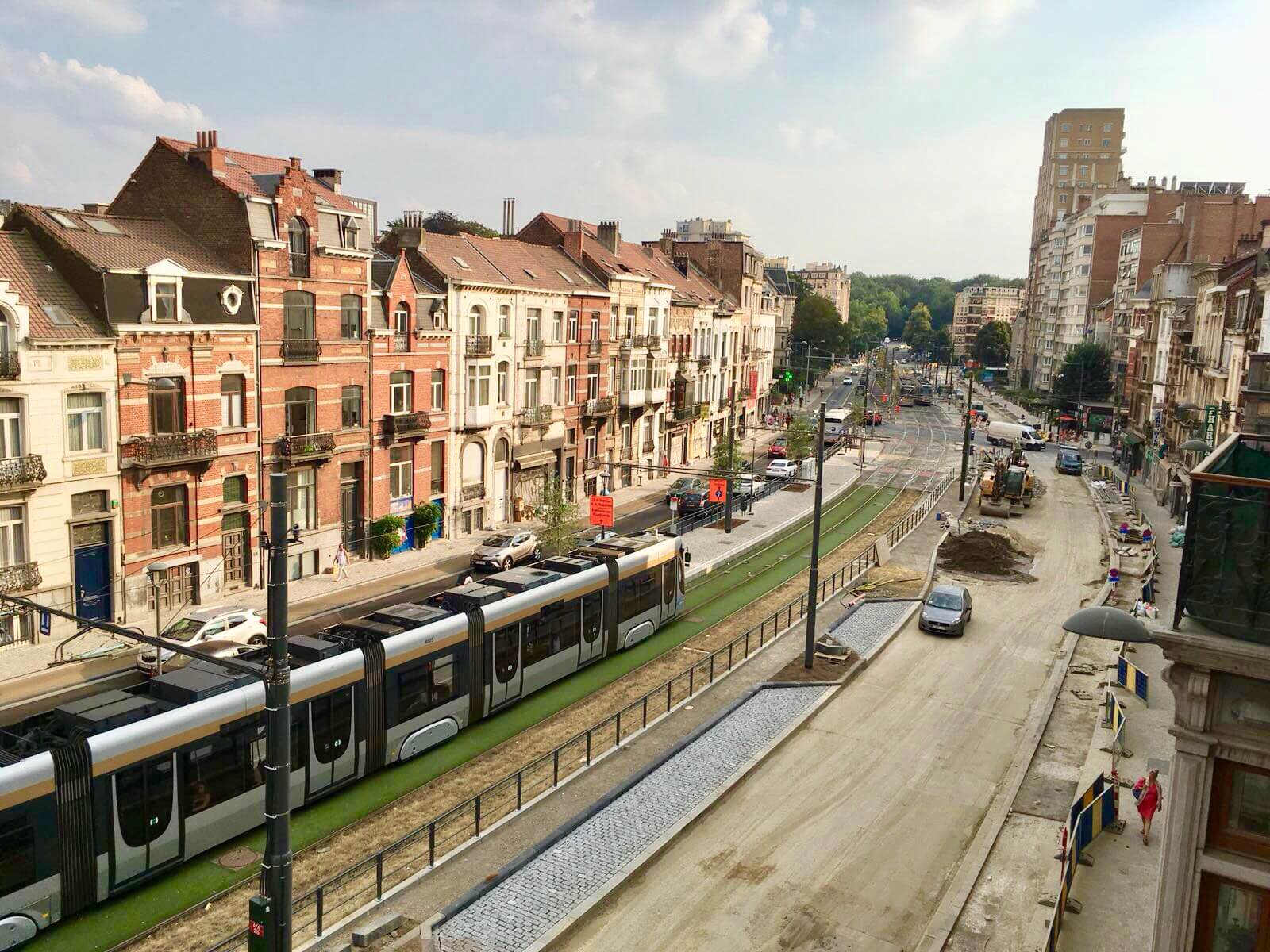
Boulevard Général Jacques.
At Etterbeek Station, one stop further on, where Avenue de la Couronne intersects the boulevard, one such is being done up and put to good use by the ever-expanding university. What was dusty and forlorn is now looking jazzed up and spiffing. I cannot help but shudder slightly every time I pass it, however, as I saw a photograph long since of rounded up, terrified Jews, some mere children, being marched out of its main gate by Nazi troopers taking them to the nearby station, thence to board trains doubtless bearing them to their grisly fate somewhere in the frozen east.
A little further on there is what has to be – I have no hard evidence for this – Brussels’ most scattered about tram stop. Buyl has four separate stops, one each for those heading north, south, east, and west. Signage there is none and the constituent parts are separated by 100 metres of the urban equivalent of skree - cobble stones. Get to the wrong one, very easy to do, and you face a death-defying schlep across General Jacques, Brussels’ very own Formula 1 racetrack.
Right after the next stop – the Gothically named Cambre-Étoile – you are afforded, to your right, a view along Avenue Franklin Roosevelt to the beginning of the Abbaye de la Cambre grounds which sweep down to the Ixelles ponds.
Up above the trees, about 20 metres up, some rather exciting derring-do occurred 80 years go. It was here that, on January 20, 1943, Flight Lieutenant Jean de Selys Longchamps of the Belgian section of the RAF, in defiance of orders, flew his Hawker Typhoon fighter-bomber over Brussels. He followed the future 7 tram route past Etterbeek station to the more open ground of the Abbey. This afforded him a direct approach to 453 Avenue Louise, the headquarters of the dreaded Gestapo, which he machine-gunned. Incredibly, he made it back to England unharmed but died later that year landing in Kent after a raid on Ostend. There is an elegant monument to him on the traffic island where tributary Avenue Emile de Mot meets Avenue Louise.
Phantom toll gate
As the tram rumbles across the Avenue Louise, you can catch a glimpse of the two toll gates at the entrance to the Bois de Cambre. No one was ever charged a toll to enjoy this finger of green which points deep into urban Brussels. They, the toll gates, were moved from the entrance to medieval Brussels itself when the park was laid out in the northern extremity of the Sonian Forest 1861.
The park was part of the gentrification of this part of Brussels and is a little more than a square kilometre. It boasts a (mostly) artificial lake, a skating rink, a pony club, at least two ginguettes, miles of wooded paths to get lost in, and a fantastically complex set of traffic rules involving three differing permutations which depend upon the day of the week, public holidays and other criteria too fantastical to be comprehended. I run in it and I never quite know if I am about to become roadkill or not!
The park was conceived, along with the development of Avenue Louise, in the early days of the Belgian state. Because the then king, Leopold II, wished to stay within the commune of Brussels when riding his carriage out to the park, he decreed that Louise, then in the rural village of Ixelles, should be part of Brussels (did he perhaps fear that Ixelles was a festering hotbed of republicanism, simmering in Europe at the time?) After long, bitter, and fruitless negotiations there was a judicial land grab. This explains, in part, the extraordinary shape of Brussels commune; and why Ixelles is the only municipality in Brussels, and possibly Belgium, in two bits like Trinidad and Tobago!
The tram veers to port at Chaussee de Waterloo and then right along Avenue Winston Churchill. On the south-west corner of their confluence is the iconic Brasserie Georges. With its gleaming brass and shining wood, long black-aproned waiters fishing for change in waistcoat pockets, piles of shellfish on ice outside, a sturdily traditional menu, and, of a foggy winter’s evening, cheerful lights inside and out it is truly a sight to behold – Parisian in the very best sense of the word.
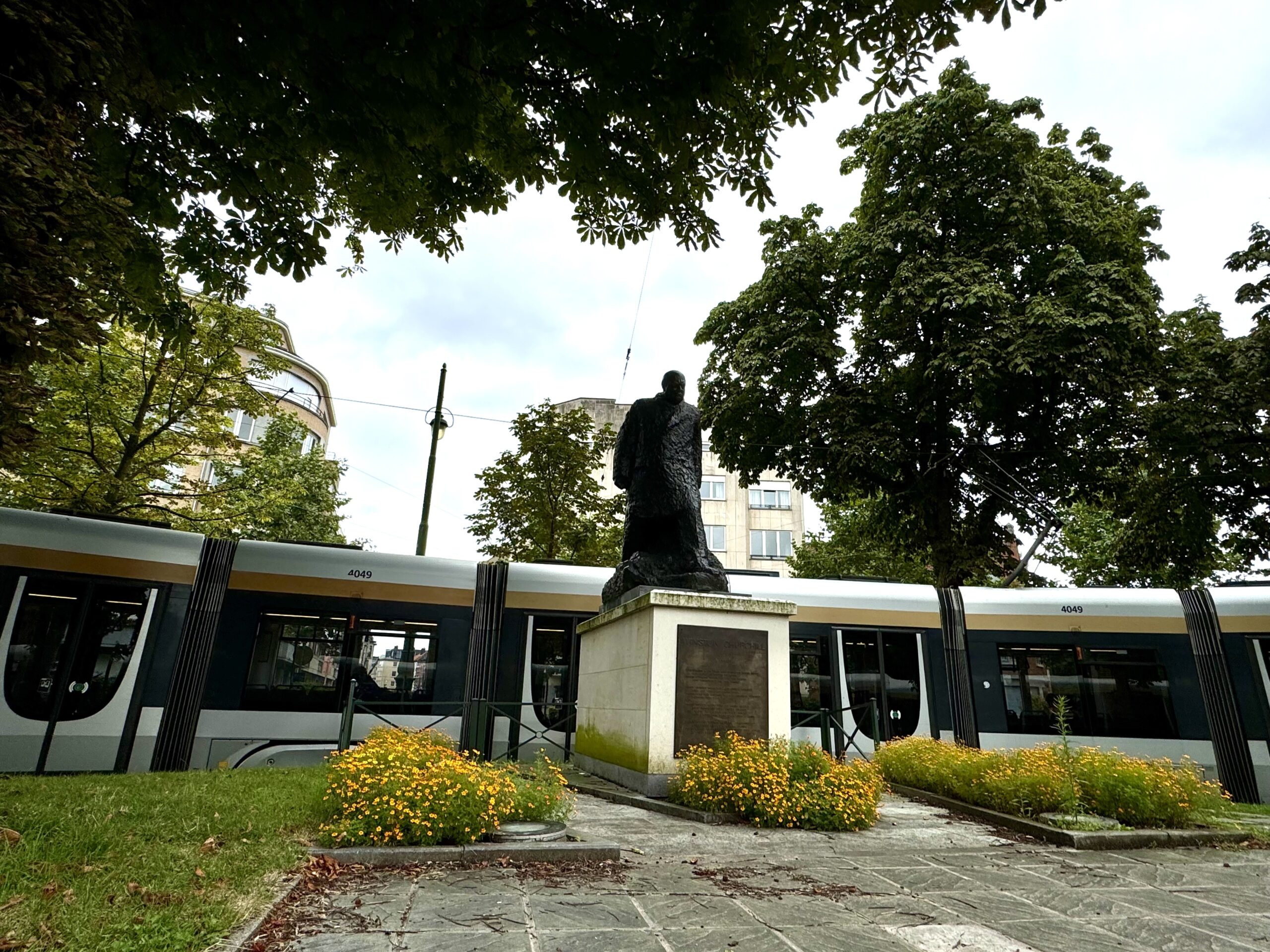
Statue of the eponymous statesman at Churchill.
The tram’s final stop is at Vanderkindere, where Avenues Brugmann and Churchill meet. However, it does not wait there before starting its return journey. It goes back to the previous stop, Churchill, which is on the eponymous roundabout on the eponymous street and has an eponymous statue of the eponymous statesman!
This manoeuvre is, I assume, to allow several trams to await peacefully on the circumference while the other line user, tram 3, can pass through along the diameter. I overheard one disgruntled soul complain bitterly that you can see a tram is not departing for six minutes and still miss it. This because of inconsiderate traffic whizzing around the roundabout like electrons round an atom (my simile).
Personally, I think that is an exaggeration.


